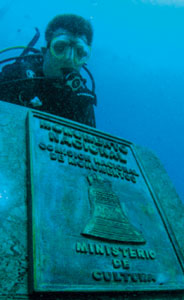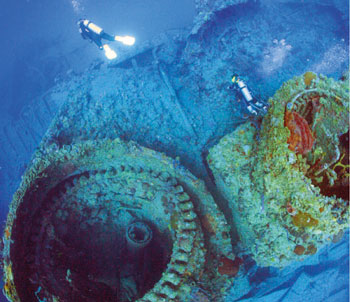 The Archaeological Park Batalla Naval de Santiago de Cuba, as a result of study and documentation, has been declared a National Monument. To record it, two plaques have been placed, the first in the Morro Castle San Pedro de la Roca, at the entrance to the Bay of Santiago de Cuba, the second at the foot of the remains of the cruiser Acorazado Oquendo, in Juan Gonzalez Cove, west of the city. This declaration is not the ultimate goal for us, but the beginning of intensive protection and conservation of this legacy, a work that is essential to ensure the knowledge and enjoyment by present and future generations of the cultural heritage of our peoples.
The Archaeological Park Batalla Naval de Santiago de Cuba, as a result of study and documentation, has been declared a National Monument. To record it, two plaques have been placed, the first in the Morro Castle San Pedro de la Roca, at the entrance to the Bay of Santiago de Cuba, the second at the foot of the remains of the cruiser Acorazado Oquendo, in Juan Gonzalez Cove, west of the city. This declaration is not the ultimate goal for us, but the beginning of intensive protection and conservation of this legacy, a work that is essential to ensure the knowledge and enjoyment by present and future generations of the cultural heritage of our peoples.
The importance the waters of Greater Antilles hold for more than five centuries of naval history, as an element of communication between different peoples and cultures was momentous. The Atlantic Ocean and the Caribbean Sea have witnessed an important part of our history in which different cultures have left material traces, different periods of splendor of our past and of other peoples. This material culture that forms the underwater archaeological heritage is now a cultural historical heritage of the Cuban nation.
The area of the coastline of the southeastern province of Santiago de Cuba was the scene of one of the most significant naval events in the history of Cuba and the world. The bloody and unequal naval battle, which ended with the sinking of the fleet of Admiral Pascual Cervera y Topete, ended the Spanish colonial rule in America, and this gave way to the emergence of the most powerful empire in the history of mankind: United States.
The vestiges of that naval cross shapes what is now known as the Archaeological Park Batalla Naval de Santiago de Cuba, made up of seven archaeological sites where the wrecks linked to landing and naval conflict as well as all the material evidence lie: masts, masteletes, remains of the rigging of the masts, fittings, parts of artillery emplacements, thick shells or medium caliber, balusters and mechanisms powertrain system belonging to ships that are related in one way or another with the facts. Likewise, the wreckage lying on the seabed have been articulated in more than a century of rest and biological activity, special ecosystems where sessile fauna and marine flora have been merged with the wrecks in a symbiotic entity that protects them mutually.
Despite the enormous historical, patrimonial and environmental value of the wrecks that are creditors, the actions taken towards its conservation are still not enough. The observations in situ of each made over the years by researchers and specialists have allowed verifying the actual degree of deterioration thereof, and the progressive and systematic destruction and loss of its components, in part by the dynamics of the medium marine and extreme weather events, but mainly by anthropogenic action.
 Underwater cultural and natural heritage refers to all traces of human existence that has been submerged under water, whether land or sea, and which has some significance for the preservation of the history of humanity in its relationship with the environment. This heritage, to which a boat or a city can belong, has the sui generis feature of being in a special environment, where natural values of ecosystems and their biotopes individuals interact decisively with cultural values, since they overlap with these in a dialectical unity which is decisive for its conservation, the only guarantee for its legacy to future generations as a shared heritage.
Underwater cultural and natural heritage refers to all traces of human existence that has been submerged under water, whether land or sea, and which has some significance for the preservation of the history of humanity in its relationship with the environment. This heritage, to which a boat or a city can belong, has the sui generis feature of being in a special environment, where natural values of ecosystems and their biotopes individuals interact decisively with cultural values, since they overlap with these in a dialectical unity which is decisive for its conservation, the only guarantee for its legacy to future generations as a shared heritage.
However, the process of conservation of underwater cultural and natural heritage, referring to a set of human actions in order to safeguard universal values, is an expression, and so dependent, the cultural level possessed by individuals who set themselves up as managers thereof, or else they perceive as a universal treasure, which also belongs to them, they can not intervene in its preservation. This is reinforced by the fact that the biggest threat facing these archaeological sites comes from human actions, not natural, which, either for the sake of plunder or simple ignorance, rapidly destroy those values. It is attributable to man the looting and irreversible degradation, while damage caused by natural elements transform and degrade over time, but can be mitigated or avoided with proper management plan for conservation. Therefore this process passes through the systematization of the financial and environmental sensitivity of the subject, in dialectical unity between empowerment and satisfaction of needs, allows the appropriation of the required culture, and with it the achievement of conservation.
Publicaciones relacionadas

Obras de García Márquez para celebrar Halloween
Octubre 30, 2024
Cerrado por obras: Museo Sorolla
Octubre 29, 2024
La Mascarada llena de color y vida a Costa Rica
Octubre 28, 2024















